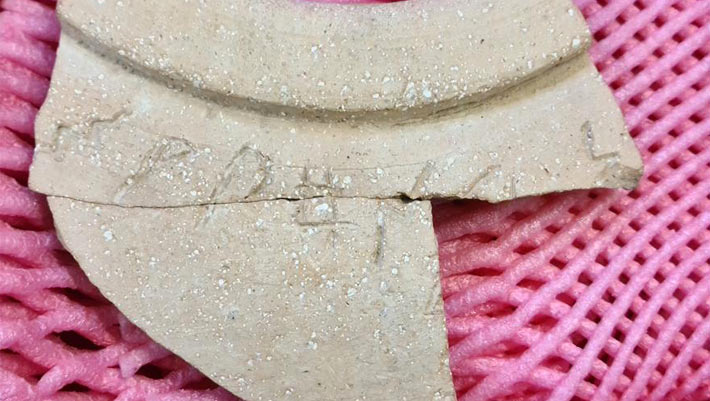During the 2012 excavations in Jerusalem, Israel, a partially preserved inscription engraved on the shoulder of a pithos was found in a context dated to the 10th century BCE. Although close to a dozen interpretations of the inscription have been offered over time, its reading remains highly disputed. All of these interpretations consider the script to be Canaanite. In his new paper, Dr. Daniel Vainstub argues that the inscription was engraved in the Ancient South Arabian script and that its language is Sabaean: the inscription reads ‘[]šy ladanum 5;’ the aromatic labdanum (Cistus ladanifer), rendered as lḏn in the inscription, is most probably ‘šǝḥēlet,’ the second component of incense according to Exod 30:34; the inscription was engraved before the locally made vessel was fired, leading to the conclusion that a Sabaean functionary entrusted with aromatic components of incense was active in Jerusalem by the time of King Solomon.
The 10th-century BCE inscribed pithos from the Ophel, Israel. Image credit: Daniel Vainstub / Eilat Mazar.
In 2012, Israeli archaeologist Dr. Eilat Mazar and her colleagues unearthed the partial remains of seven pithoi (large storage containers) during the excavations in the Ophel, between the City of David to the south and the Temple Mount to the north.
The pithoi, one of which had an inscription, were found in a context dated to the 10th century BCE (Early Iron Age).
The inscription was located below the pithos’s rim; it was engraved before firing, and seven of its letters have survived.
Since the editio princeps of the inscription, close to a dozen researchers have offered different readings and interpretations. However, the reading and meaning of the inscription remain controversial.
The common denominator of the previous interpretations of the inscription is that the script is Canaanite.
Instead, in his new article, Dr. Vainstub argues that the inscription was engraved in the Ancient South Arabian script in its earliest phase, dated to the beginning of the first millennium BCE and that its language is Sabaean.
“Deciphering the inscription on this jar teaches us not only about the presence of a speaker of Sabaean in Israel during the time of King Solomon, but also about the geopolitical relations system in our region at that time — especially in light of the place where the jar was discovered, an area known for also being the administrative center during the days of King Solomon,” Dr. Vainstub said.
“This is another testament to the extensive trade and cultural ties that existed between Israel under King Solomon and the Kingdom of Sheba.”
According to the new interpretation, the inscription on the jar reads‘[]šy ladanum 5,’ means five ‘šǝḥēlet,’ referring to one of the four ingredients mentioned in the Bible (Exodus 30:34) required for the incense mixture.
“The ‘šǝḥēlet’ was an essential ingredient in the incense that was burnt in the First and Second Temples and was called ‘tziporen’ in Rabbinic literature,” Dr. Vainstub said.
“This indicates a clear connection between Jerusalem of the 10th century BCE (the days of the Kingdom of Solomon) and the Kingdom of Sheba.”
“It appears that the pottery jar was produced around Jerusalem and the inscription on it was engraved before it was sent for firing by a speaker of Sabaean who was involved in supplying the incense spices.”
The paper was published in the Jerusalem Journal of Archaeology.
_____
Daniel Vainstub. 2023. Incense from Sheba for the Jerusalem Temple. Jerusalem Journal of Archaeology 4: 42-68; doi: 10.52486/01.00004.2




